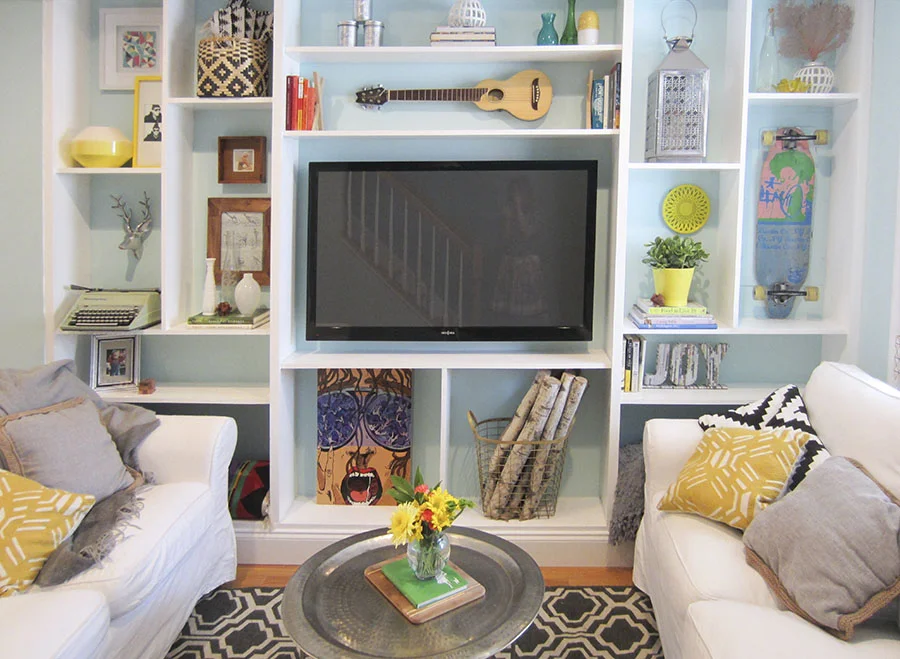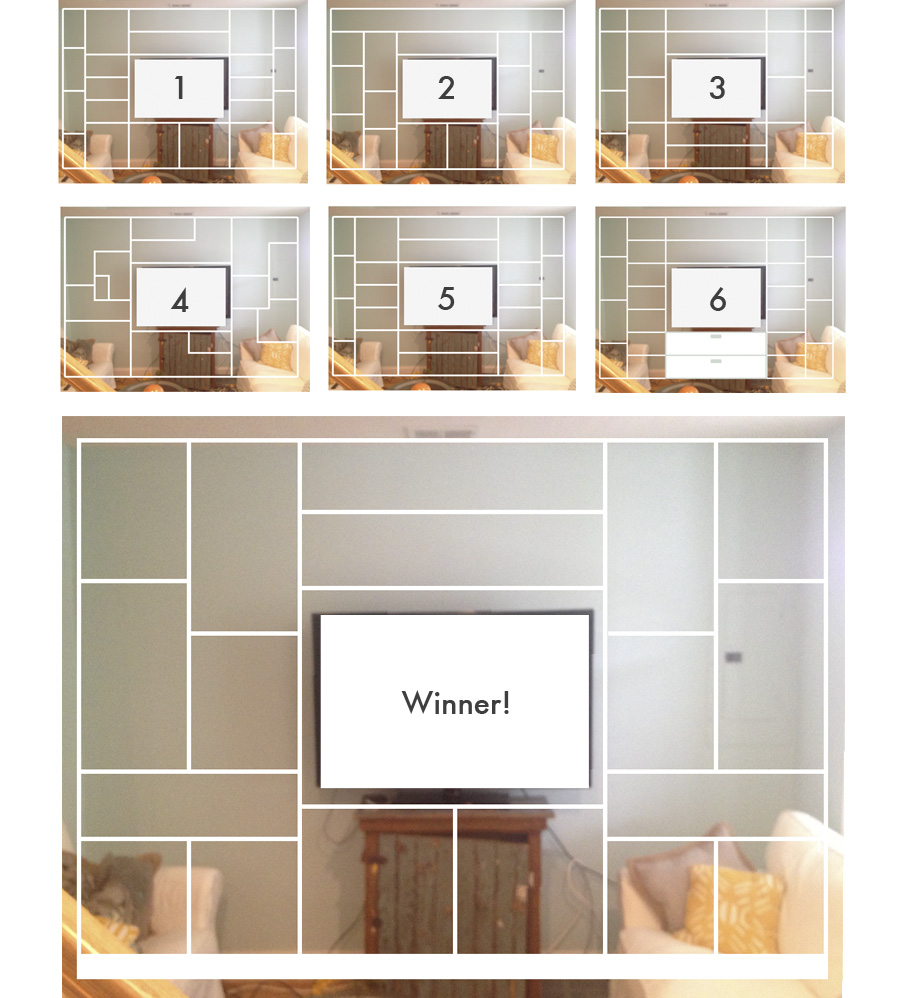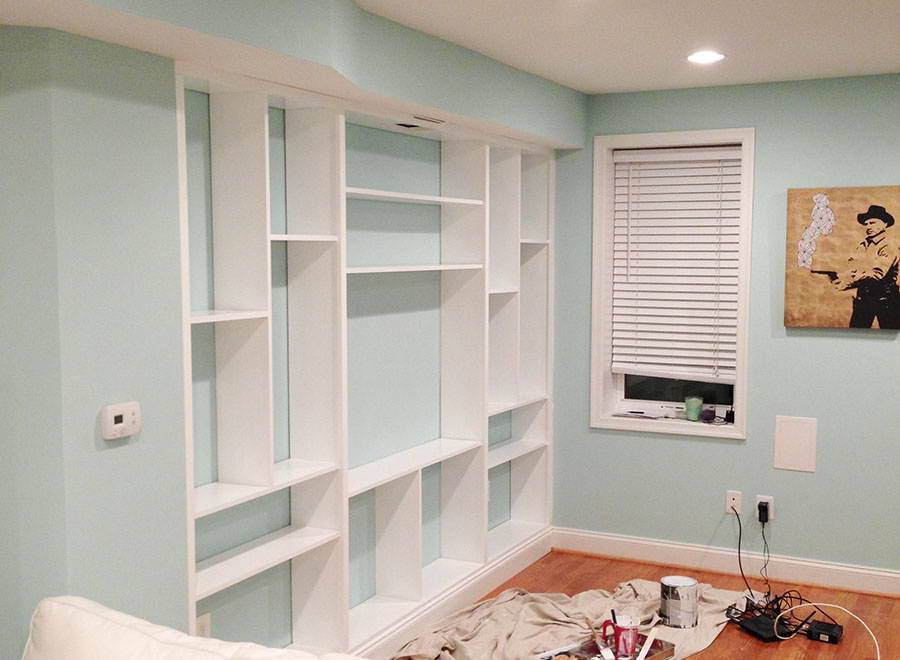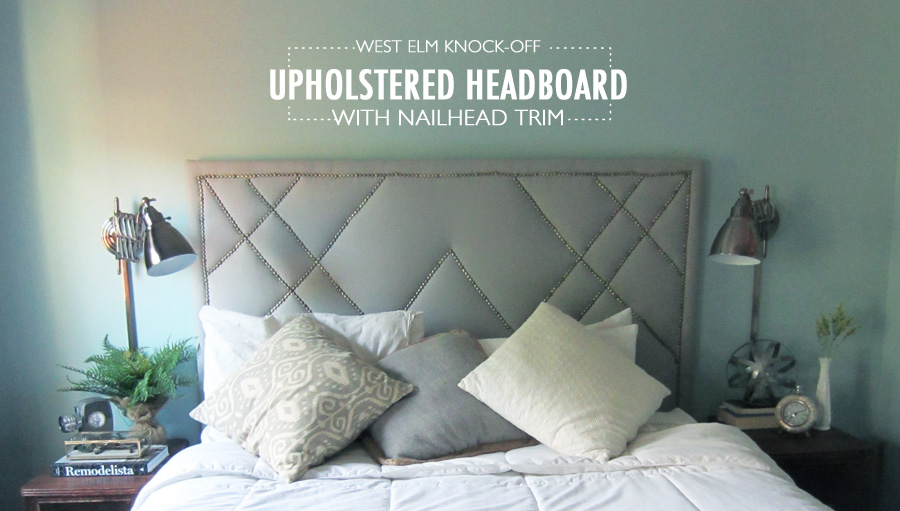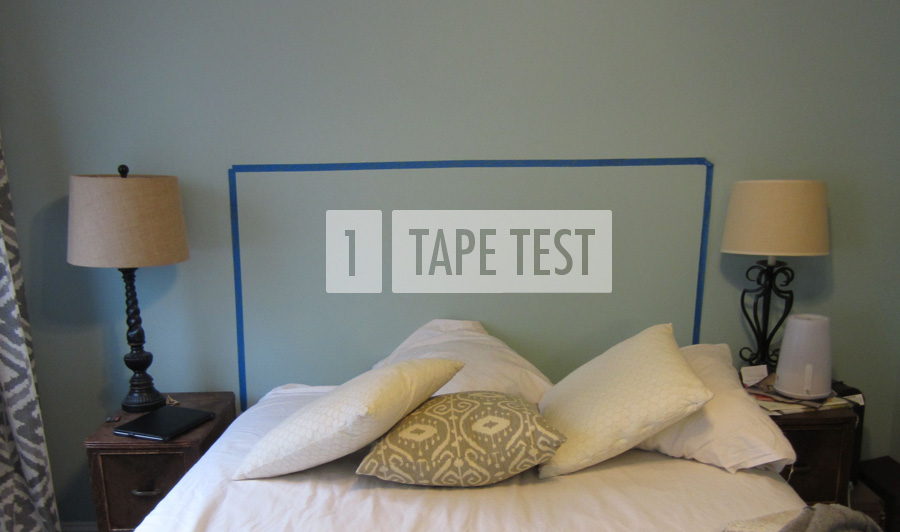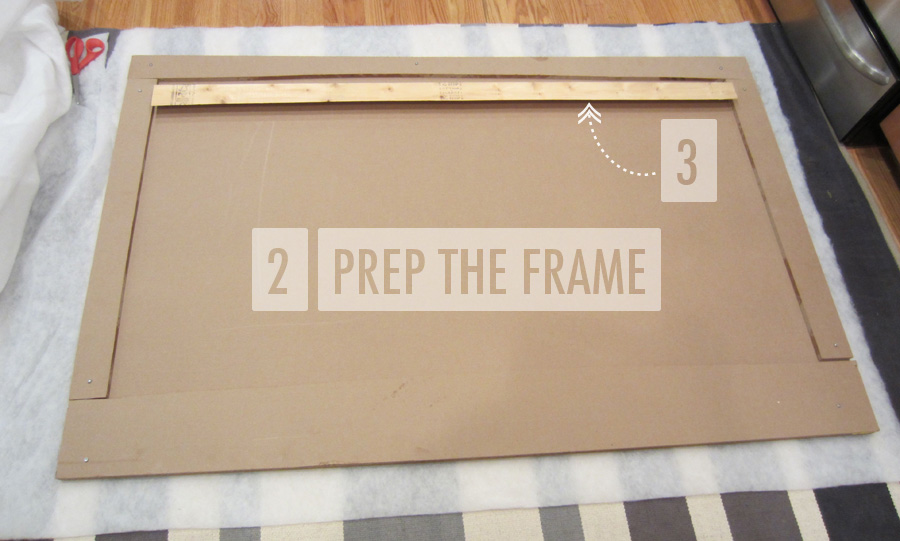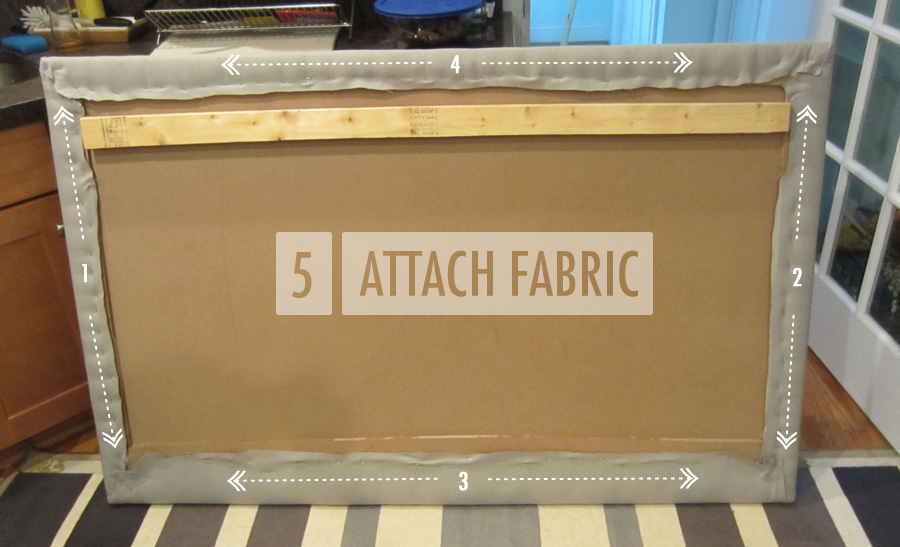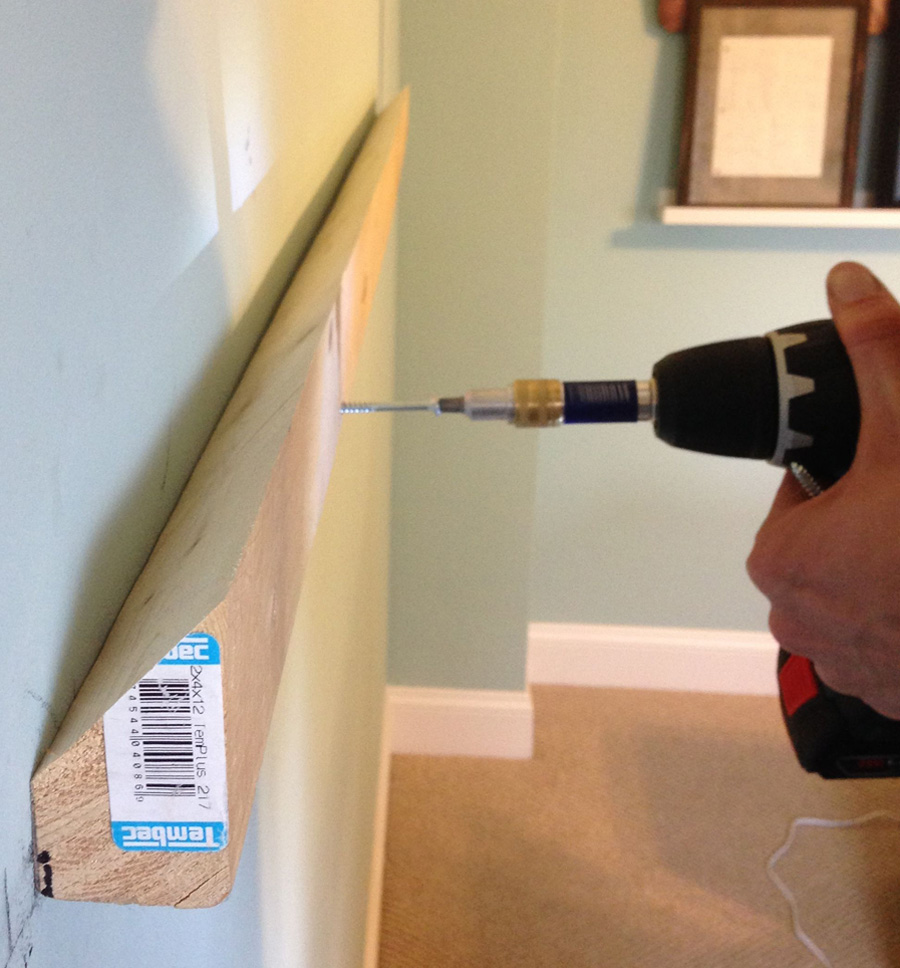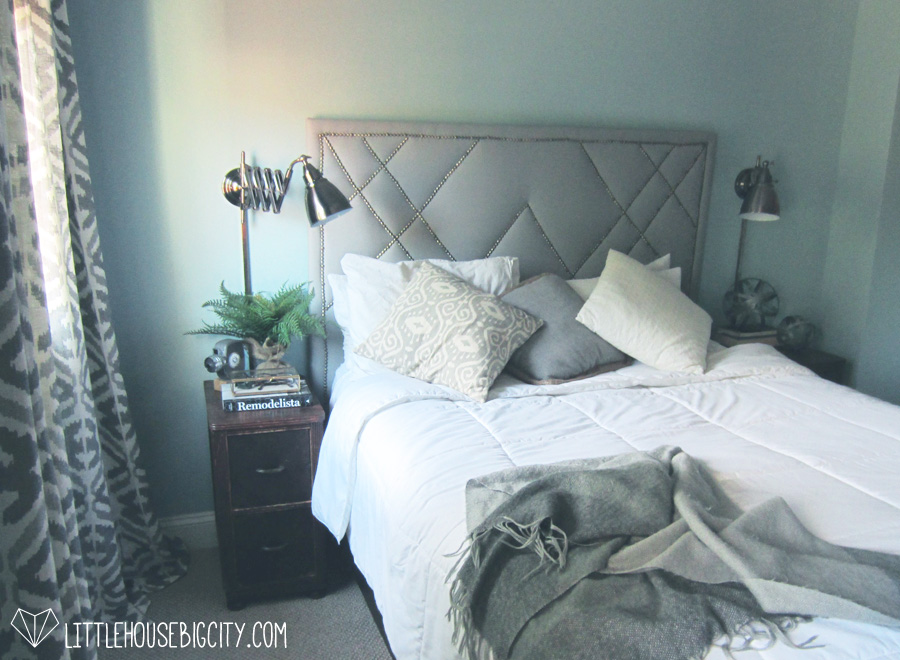When I first launched the blog & a home tour, the project everyone seemed most interested in was the built-in bookcases. I planned to make it one of my first posts and it was no doubt going to rocket me into superBlogdom ;) Yet here we are, 8 months later and still no built-ins -- or superBlogdom, for that matter! Please, please, please forgive me for testing your patience, friends. It’s now been almost a year and a half since we built the shelves – they're twice as old as the blog – and while I could have sworn we documented every step of the process, most of those photos are no where to be found.... excuse me while I find a corner to cry in.
A handful of photos were miraculously recovered from the ether, and they will have to do. Really the process of designing, planning and building could be split over 2 posts but I like to test the limits of your attention span (plus I simply don't have enough photos to justify more than 1 post). So get excited guys! Lots of words and few photos – I hope you've had your coffee! ;)
First lets take a look at where we started:
We knew the living room was going to be tricky before we bought the house. Eli had a huge TV, and we had a not-huge living room to hide it in. We considered a lot of options but ultimately decided it should go on the only full wall available. That wall was also the only one that could fit a full-size couch but priorities, people! TV > couch. I spent a few weeks looking for a midcentury-style credenza to swap in place of that clearly too-small cabinet, but all the ones I found were too long, too deep or too expensive. Sooo I gave up on that idea and set my heart on custom shelves. Naturally.
Step 1: Design & Plan
I came up with the design by snappin’ an iPhone pic of the wall and bringing it into Adobe Illustrator, where I spend most of my days. I started drawing shelving designs over the picture until something stuck. There were a few fixtures to work around: the TV (obviously), the circuit breaker box (to the right), a vent (top, middle) and a couple electrical outlets. I also figured having lots of different sized areas to fill would give me more options for what to put in them and look a little different from what I've seen on pinterest. More on that in a later post.
What really sold me on this configuration were the double-wide horizontal cubbies (for lack of a better word) on either side of the TV. They're about even with the sofa arms (more-so in real life), and I envisioned them to serve as end tables since the room is otherwise too narrow for such luxuries. The cubbies themselves are tall enough to comfortably accommodate just about any drinking vessel you might choose... except maybe a wine bottle but get a glass for crying out loud! ;)
So once I settled on this design I measured the wall, measured my fixtures, and did the math to figure out the actual dimensions of my drawing. In other words, I found it easiest to work backwards. From those measurements, we created a lumber list. We pulled up Home Depot’s website to see what our options were and which lengths were most cost effective, and then did more math to figure out how to minimize waste. I was basically Russell Crowe in A Beautiful Mind. I color-coded my sketch by the length of wood that shelf would come from, and it served as our reference throughout the process. If we cut from a 6 foot board when we were supposed to cut from a 12 foot, we’d be left with an unusable amount of scrap and have to go back to the store for more wood. Ya dig?
Step 2: Shop
Ultimately we settled on this shopping list:
- Seven 1" x 10" x 12' - I think we went with pine
- One 1" x 10" x 10'
- One 1" x 10" x 6'
- Two 2" x 4" x 12' - This is what I wrote down at the time but I'm seriously doubting we needed that much
- One 12' piece of base molding
- Two 1" x 2" x 12' piece of pine trim
- One 1" x 2" x 8' piece of pine trim
- Two packs of 2" phillips flat head wood screws
- One pack of 1.5" finishing nails
- Wood filler
- White, paintable caulk
- 1 gallon and 1 quart of Zinsser Bullseye Primer
- 2 gallons of Behr Premium Ultra Pure White in Semi-Gloss finish
- Angled paint brush
- Small paint rollers
Other than the 2x4s, all the boards were 10” wide (really 9.75”). That worked great for us because the shelves butt up against a wall that juts out 10.25”. After adding the 3/4” thick trim to the shelf fronts, we’d have a pretty smooth transition from shelving to wall. When shopping for lumber we looked for straight boards that didn’t have cracks, holes or tons of knots. To check straightness, we’d bring a board down to the floor, lift one side up to eye level, and squint while looking down the board and rotating it to check every side. If it bowed or had a damaged edge we put it back and grabbed another one. You’ll see in the pictures that the ones we chose weren’t perfect – there are higher quality options out there for a higher price. We went with paint grade, but you’d need a nicer quality if you wanted to stain them.
We decided against renting a truck to bring the lumber home, so Eli’s station wagon & knotting skills really came in handy. Picture me terrified, clutching the boards from the passenger seat ready to use my she-woman strength at every bump turn and pothole, while insisting at least 10 times that "I should sit in the trunk to make sure they don't go anywhere." I'm sure all that "excitement" only shaved a few days off my life – a small price to pay to save a buck ;)
Before I go any further I should clarify – we are not carpenters. We had never built a legit piece of furniture before, let alone something this big, so we just took it slow and figured it out as we went along. I’m sure a pro would have done a better job but I didn't have a few grand laying around to find out. I’d read some tutorials (likes these here & here) and incorporated details from each to get to a final product that we’re mostly very happy with. There are things I would have done differently a second time around, as well as things I still plan to alter, but I’ll save those for the end. This is just one way to do tha dang thang.
Step 3: Construction
We started by building the outer frame and the full-length vertical boards on either side of the TV – these 6 boards form the supports for the rest of the design. We made our cuts on the back deck with a circular saw and did all of the assembly in the living room – we didn’t want to risk the shelves not fitting through doorways or causing them to torque and break while navigating the house. We used a level, carpenter’s square and tape measure to make sure the boards were good to go before screwing them together. I held them in place while Eli used his countersinking bit to pre-drill the holes & then screwed them together. We pre-drilled everything to avoid splitting the wood.
I wanted to continue the base molding along the bottom, so the height of the shelves is actually measured from the top of the moulding to the ceiling. Then we created base supports out of 2 x 4s to hold them up. These risers are just rectangular blocks that we screwed together and spaced every 16 inches or so (seen in the top left corner in the above photo).
Once we had the basic frame assembled we carefully slid it onto the supports against the wall to test the fit and breathed a huge sigh of relief when it did indeed fit.
Word to the wise: leave yourself a little bit of space width-wise so you can slide the shelves in & out without having to scrape against the walls. We hid that space later. After doing our first little victory dance of this saga we carefully laid the frame baaack on the floor to finish assembly.
That's me marking the height for the "side table" shelves to fit all your beverage desires. We kept a level & square handy to check our shelves and corners often.
Step 4: Patch & Sand
By the time we finished assembling there were a lot of screw holes to fill in, plus general imperfections in the wood that I wanted to hide. I'm fairly certain a carpenter would have created pocket holes to do the joining and then fill the holes with plugs, but that was beyond our skill set.
I ignored everything on the outside of the frame since that would all be hidden against the wall, but all the visible holes got a good dose of Elmer’s wood filler applied with a putty knife. My wood filling photos are MIA, but that's probably for the best. Let’s just say I went totally overboard -- piling on the filler in big heaps & not scraping off the excess before letting it dry. Never again! That stuff turns rock hard, and the small mountains I created for myself were a huge pain in the ass to sand down.
I used my B&D Mouse sander and went thru an entire pack of rough 80 grit plus another pack of fine 400 grit before it was silky smooth. By that time I'd also turned the downstairs into the Dust Bowl -- every surface was covered in a crazy thick film and it took forever to clean it all up. Next time I’d use less filler, scrape off all the excess while it’s still wet, quarantine the area with a plastic tarp like we did when painting the cabinets, and wear a sanding mask or respirator!
Step 5: Prime & Paint
Given all the dust, I was really careful about cleaning the shelves before cracking open a can of primer. I vacuumed, swept, wiped down with a wet cloth, and wiped down with a tack cloth before declaring the area dust-free. When everything was spick and span I laid down a drop cloth and got to “the easy part”…
I foolishly thought 1 coat of primer and 2 coats of paint would be enough to get really even coverage but it took more like 2 coats of primer and FOUR coats of semigloss paint. Claw hands 4 lyfe.
I used an angled brush for the corners and a 6” roller for everything else. I did this before we moved the shelves into place so I wouldn’t have to worry about taping off or retouching the wall.
After we were 100% sure everything was dry, it was time to put the shelves in their final resting place. We used a stud finder on the walls that would flank the shelves to figure out where we could anchor them in. Once we had a general idea of where they were we nervously shimmied the shelf to the wall, hoisted it up onto the 2x4 blocks, and secured it in place. We drove several screws thru the sides of the main frame and into the studs. In an abundance of caution we also used small L brackets to lock it to the back wall. This thing still feels super sturdy after 16 months but I haven't been using it as a jungle gym or anything. Of course, after locking it down we had a few more holes to patch and paint, but I was a pro by that time.
Are you guys still awake? Pat yourself on the back and rest assured that you're almost to the end. The fun didn't stop there, guys!
Step 6: Trim & Moulding
Walls are rarely perfectly level & we'd left ourselves some wiggle room to get the shelves into place, so there were small gaps here and there that we hid by installing 2” x 1” oak trim with finishing nails. Gaps be gone! I made a controversial decision to only install trim on the boards that ran full lengths… so the outside frame and the two vertical posts on either side of the TV. This gave those edges a nice beefy look, but now that we’ve lived with it like this for a while, I want to add trim to the rest. I'm getting the sense that the wimpy ones are envious of their beefcake neighbors. (Whether I actually get around to doing this is another matter) After the trim was in place, we installed base moulding along the bottom.
Step 7: Caulk & Touch-Ups
Caulk was the silent hero in getting the polished, built-in look. We caulked all the seams, edges and little nail holes left from attaching the trim & moulding, and then touched up the paint. It’s a good idea to actually paint over the caulk when it’s dry to make it easier to dust and clean down the line. Those gaps along the back wall in the picture above are suddenly gone in the picture below. Caulk is magic!
And that's how we built the shelves! If you really want to know, there are a few things I would have done differently and a few things I plan to actually do something about.
What I’d do differently:
- If we were to do this again I would have removed the base & shoe moulding from the walls behind the shelves. It was helpful to have the baseboards there because we rested the shelves on them while sliding the 2 x 4s in, but it also made it impossible to get a seamless transition from old to new base moulding. Luckily those corners are hidden by the couches, so it doesn’t bother me on a daily basis (just times like now where I’m revealing our folly to the world).
- The vent above the shelves was inconveniently placed, so we ended up cutting a hole in the top board to accommodate it (fine) and cut a notch in the trim to go on top of it (mistake). We should have created some sort of extension for the vent to nudge it closer to the wall and then used 1 complete piece of trim across the front to hide it altogether. Doh! Some day when we've fried our bigger fish we'll come back for this guy.
- Think about what I wanted to put in the shelves. I took a Field of Dreams approach thinking all the pretty things I didn't yet have would find their way to our built-ins if I just built the things, but that has been more of a challenge than I thought. The cubbies below the TV, for instance, are an awkward size. I thought maybe some pretty baskets could sit there and hold extra blankets and pillows, but i's a pretty shallow shelf for a wide and tall basket. One thing I definitely plan to change is to add doors to at least some of the bottom cubbies...either those middle ones, or the outside ones, or both. I haven't decided the specifics yet, but it will happen!
- Already said this but will say again -- trim on all edges! I liked the varied look at first, but now I wish they were all thick and substantial looking. Plus those trimmed edges just look smoother in person.
I think that's it. Like I said, they aren't perfect but we're very happy with them in general. At some point I'll finally get them styled to my liking and then really rejoice! What do you guys think? Would you consider building your own wall of shelves?

